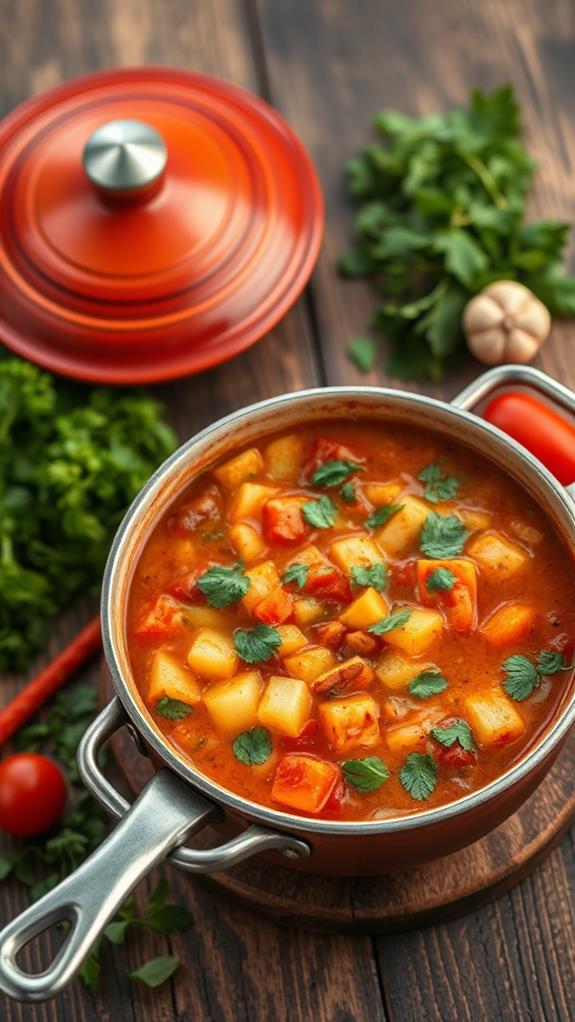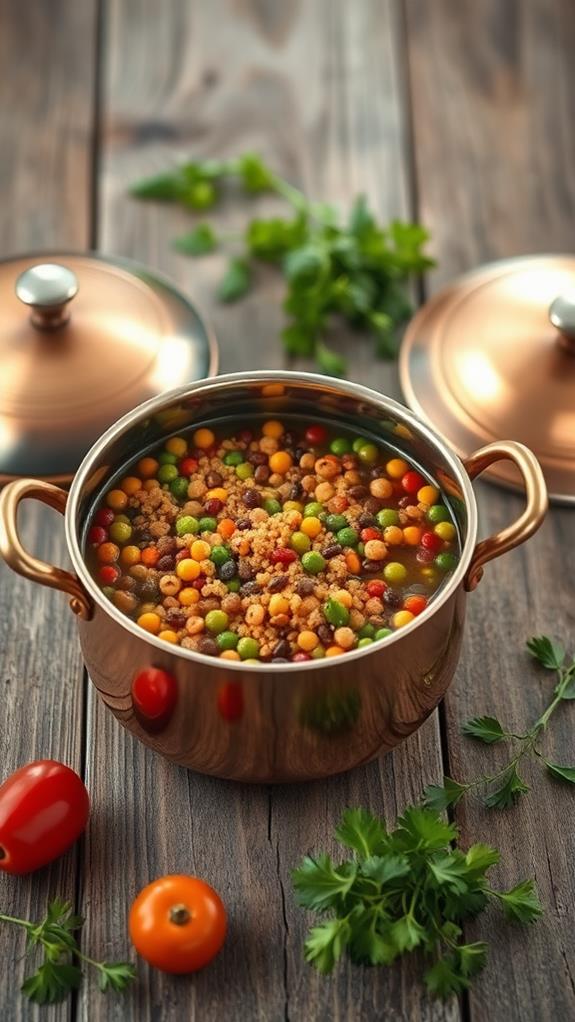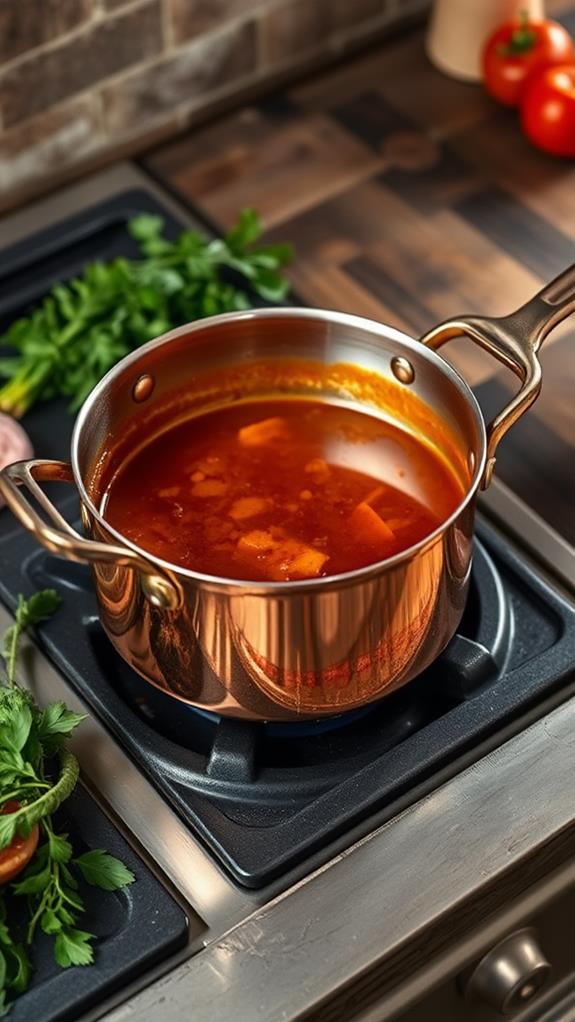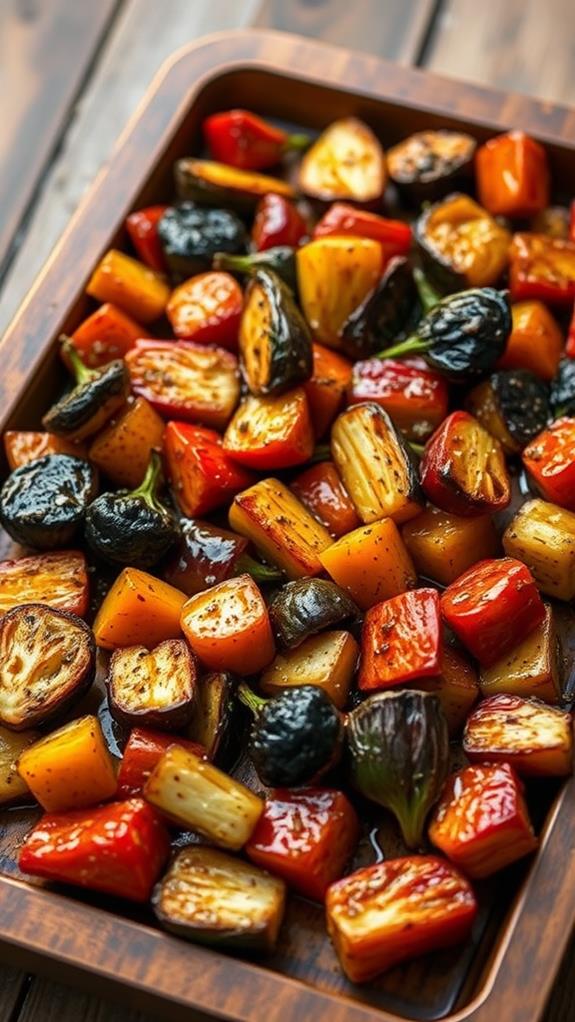What to Do With Vegetable Stock Leftovers
Leftover vegetable stock is a culinary goldmine you shouldn't waste. Use it as a flavorful base for soups, stews, and chowders, or to cook grains and legumes for added depth. It's perfect for creating rich sauces, enhancing vegetable side dishes, and even crafting savory baked goods. You can substitute it for water when cooking rice, quinoa, or lentils, or use it to braise vegetables for extra flavor. Don't forget to freeze portions for future use in ice cube trays or small containers. With these versatile applications, you'll transform your leftover stock into delicious, nutrient-packed meals. The possibilities are endless when you tap into this flavor-packed ingredient.
This post may contain affiliate links. If you make a purchase through these links, I may earn a commission at no additional cost to you. Additionally, portions of this post may be generated using artificial intelligence (AI) technology. While we strive for accuracy, please be aware that AI-generated content may not always be perfect and should be fact-checked when necessary.
The Spatula Scoops
- Use leftover vegetable stock as a base for soups, stews, and chowders.
- Cook grains and legumes in vegetable stock instead of water for added flavor.
- Create rich sauces and gravies using vegetable stock as a flavorful liquid base.
- Enhance vegetable side dishes by braising, sautéing, or roasting with stock.
- Freeze leftover stock in small portions for convenient future use in various recipes.
Make Flavorful Soups and Stews

How can you transform leftover vegetable stock into delicious meals? One of the most versatile ways to use your remaining vegetable broth is by creating flavorful soups and stews. Start by using it as a base for classic favorites like potato-leek soup, hearty chowders, or nutrient-packed lentil stews. The rich flavor of the broth will enhance these dishes, giving them depth and complexity. For a tangy twist, consider adding a splash of cultured buttermilk to your soup, which can enhance flavors and provide a creamy texture without excessive calories.
If you're cooking with beans or lentils, consider using the leftover broth to pre-cook these legumes before adding them to your soup. This method infuses them with extra flavor, elevating the overall taste of your dish. For grain-based soups, try combining the vegetable broth with water when cooking rice, farro, or quinoa. This simple step adds a subtle but noticeable boost to the flavor profile of your soup.
Sometimes, you might find your vegetable-packed soup has become too thick. In this case, you can easily adjust the consistency by adding more of your leftover broth. This not only thins out the soup but also intensifies its flavor. Don't forget about the flavorful liquid from pressure-cooked beans – it's perfect for cooking lentils in your next soup recipe.
Cook Grains and Legumes

A fantastic way to repurpose leftover vegetable stock is by using it to cook grains and legumes. You'll find that this method not only adds depth to your dishes but also speeds up cooking time. When preparing lentils, beans, rice, quinoa, or farro, swap out water for your vegetable broth. This simple change will enhance the overall flavor profile of your meal. Quinoa's nutritional benefits make it an excellent choice for this method, as it's a complete protein source and rich in essential minerals.
Don't let leftover cooked bean broth go to waste. If you've used a pressure cooker, save that flavorful liquid to cook lentils or other grains. It's a great way to maximize flavor and reduce food waste. You can even incorporate leftover vegetables like sweet potato into your grain dishes for added nutrition and taste.
Broth-cooked grains serve as an excellent base for various meals. Use them in grain bowls, tabbouleh, or as a foundation for fried dishes. The complex flavors imparted by the broth will elevate your cooking, creating more delicious and satisfying meals. By utilizing vegetable stock in this way, you're not only repurposing leftovers but also improving the taste and nutritional value of your dishes.
Create Rich Sauces

Vegetable stock's versatility shines when creating rich sauces. You'll find numerous ways to transform your leftover broth into flavorful additions for various dishes. Start by using it as a base for creamy white sauces in pot pies, casseroles, or pasta dishes. For a vegan twist, mix the broth with nut butters or coconut milk to create luscious plant-based sauces. Using a high-quality All-Clad D5 saucepan can help guarantee even heat distribution and prevent burning when preparing delicate sauces.
When making stir-fries, incorporate vegetable stock into your sauce for added depth and moisture. You can also thin out bechamel sauce with the broth to create a delectable pot pie filling. Don't forget about gravy – utilize your extra stock to whip up a hearty topping for mashed potatoes, roasted vegetables, or vegan meat alternatives.
To elevate your sauces, consider combining the vegetable broth with extra-virgin olive oil for a lighter consistency. You can prepare these sauces ahead of time and store them in the refrigerator for quick meal prep. For non-vegan options, a sprinkle of parmesan cheese can add a savory touch to your vegetable stock-based sauces. Remember, experimenting with different flavor combinations will help you discover new and exciting ways to use your leftover vegetable stock.
Enhance Vegetable Side Dishes

You can breathe new life into your vegetable side dishes using leftover vegetable stock. By infusing your veggies with this flavorful liquid, you'll add depth and complexity to otherwise plain steamed or roasted vegetables. Simply substitute some or all of the water you'd normally use when cooking your vegetables with your homemade stock, and watch as your side dishes transform from basic to extraordinary.
Infuse Flavor Into Veggies
Savory aromas waft through the kitchen as you transform ordinary vegetables into extraordinary side dishes using leftover vegetable stock. This versatile ingredient can infuse your veggies with rich, complex flavors that'll elevate any meal.
Start by braising carrots, potatoes, or leafy greens in vegetable stock. This simple technique imparts a depth of flavor that'll make your side dish stand out. For a quick and easy option, simmer chopped vegetables in the stock until they're tender, then season with herbs, spices, or a squeeze of lemon juice.
If you're roasting vegetables like Brussels sprouts, cauliflower, or eggplant, drizzle some stock over them before or after cooking. This adds moisture and enhances their natural flavors. When sautéing zucchini, bell peppers, or onions, incorporate a splash of stock to create a more complex and well-seasoned side.
Don't forget about mashed vegetables. Mix vegetable stock into your mashed potatoes, turnips, or parsnips for a creamier texture and enhanced savory notes. This simple addition can transform a basic side into a memorable dish that'll have everyone asking for seconds.
Elevate Steamed Vegetable Dishes
Frequently overlooked, steamed vegetables can be transformed into culinary delights with the addition of leftover vegetable stock. You'll be amazed at how this simple technique can elevate your side dishes, turning ordinary veggies into flavorful accompaniments.
To enhance your steamed vegetables, start by using the leftover stock as your steaming liquid. This infuses the veggies with a savory depth from the get-go. As the vegetables cook, they'll absorb the stock's flavors, resulting in a more complex taste profile. Once steamed, drizzle a bit more stock over the vegetables to intensify the flavor further.
For a twist on traditional steaming, try simmering your vegetables in a mixture of water and leftover stock. This method allows for even more flavor absorption, creating a herb-infused side dish that's anything but boring. Don't forget to experiment with different vegetable combinations to find your favorite pairings.
If you're looking to add some texture, consider incorporating stale bread cubes into your steamed vegetable dishes. These can soak up the flavorful stock and provide a delightful contrast to the tender veggies.
Freeze for Future Use

When you've prepared more vegetable stock than you can use immediately, freezing the leftovers is an excellent way to preserve them for future use. You can easily portion the stock into ice cube trays or small containers, making it convenient to defrost only what you need for specific recipes. This method is particularly useful when you're looking to add a burst of flavor to pasta sauce or other dishes without thawing a large quantity.
Craft Savory Baked Goods

You can transform your leftover vegetable stock into delicious savory baked goods, adding depth and flavor to your creations. Try incorporating the stock into savory vegetable muffins, which make for a hearty breakfast or snack option. For a more substantial meal, consider baking herb-infused bread loaves using your vegetable stock, resulting in aromatic and flavorful breads perfect for sandwiches or as a side dish.
Savory Vegetable Muffins
Transform your leftover vegetable stock ingredients into delicious savory muffins, perfect for breakfast, brunch, or as a side dish. Chop your leftover vegetables into small pieces and mix them with flour, baking powder, milk, and seasonings. Don't forget to add salt and pepper to enhance the flavors. Preheat your oven to 400°F and grease a muffin tin before pouring in the batter.
| Vegetable | Flavor Profile | Preparation |
|---|---|---|
| Carrots | Sweet, earthy | Grated |
| Spinach | Mild, leafy | Chopped |
| Zucchini | Subtle, moist | Shredded |
Bake your vegetable muffins for 20-25 minutes until they're golden brown. You can create a variety of flavors by incorporating different vegetables like carrots, zucchini, spinach, or onions. These savory muffins are versatile and can be served alongside soups, stews, or enjoyed on their own.
For convenience, you can freeze the baked vegetable muffins. This allows you to have a quick and healthy snack or side dish on hand, which you can reheat as needed. By repurposing your vegetable stock leftovers into these muffins, you're reducing food waste while creating a delicious and nutritious treat.
Herb-Infused Bread Loaves
Crafting herb-infused bread loaves is an excellent way to repurpose leftover vegetable stock. You'll elevate your bread game by substituting vegetable stock for water in your favorite recipes. This simple swap enhances the bread's savory notes and creates a more complex crumb structure.
When you're using vegetable stock in your bread, don't stop there. Incorporate dried herbs or finely chopped fresh herbs into the dough for added aroma and texture. This combination will result in a flavorful and moist loaf that's perfect for any meal.
To achieve the best results, bake your herb-infused bread at high temperatures. This technique will develop a golden-brown crust and caramelized flavor, making your bread even more irresistible.
Once your aromatic loaves are ready, serve them as a side to soups and stews, or pair them with cheeses and chutneys for a delightful combination. The versatility of these herb-infused breads makes them a valuable addition to your culinary repertoire. By repurposing your leftover vegetable stock in this way, you're not only reducing waste but also creating a delicious and impressive baked good.
Frequently Asked Questions
How to Use up Leftover Vegetable Stock?
To use up leftover vegetable stock, you've got several options. Cook lentils, beans, or grains in it for added flavor. Incorporate it into creamy sauces for pot pies or stir-fries. Use it to thin out vegetable soups while maintaining texture. Prepare couscous or risotto with stock instead of water for depth. You can even substitute it for water when making bread or pizza dough, creating a savory crust. These methods will help you make the most of your leftover stock.
What Should You Do With Leftover Stock?
Don't let your leftover stock go down the drain! You've got a treasure trove of flavor at your fingertips. Use it to cook grains like rice or quinoa, adding depth to your dishes. Incorporate it into soups, stews, or sauces for an instant flavor boost. Braise vegetables in the stock to infuse them with savory goodness. For future use, freeze it in ice cube trays. If you're feeling adventurous, boil it down to create a concentrated glaze that'll elevate any meal.
Can I Freeze Leftover Vegetable Stock?
Yes, you can freeze leftover vegetable stock. It's an excellent way to preserve your homemade stock for future use. You'll want to store it in airtight containers or freezer bags to prevent freezer burn. For convenience, try freezing stock in ice cube trays or small portions. This method allows you to thaw only what you need. Frozen vegetable stock can last 3-6 months without losing quality. When you're ready to use it, simply thaw in the refrigerator or microwave it in short bursts.
How Long Does Vegetable Stock Last in the Fridge After Opening?
After opening, your homemade vegetable stock typically lasts 3-5 days in the refrigerator. However, you can extend its shelf life to about a week by storing it in an airtight container. It's pivotal to monitor its appearance, smell, and taste. If you notice any off odors, unusual colors, or strange flavors, it's best to discard the stock for food safety reasons. To guarantee optimal freshness and flavor, always use your vegetable stock within the recommended timeframe.





